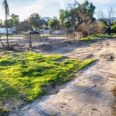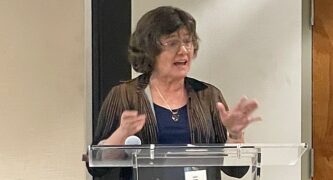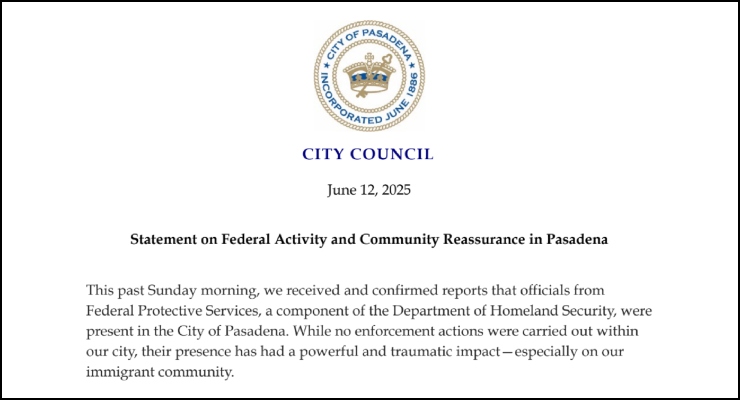
Dr. Lucy Jones. [Eddie Rivera/Pasadena Now]
When ‘The Big One’ hits, it’s going to be massive. If it strikes during daylight hours, its toll would be more devastating, said renowned seismologist Lucy Jones at an emergency preparedness and response workshop the day ahead of Thursday’s “Great ShakeOut Day” drill.
The event, held at the Los Angeles Area Chamber of Commerce, was hosted by “Together For L.A.,” and the Dr. Lucy Jones Center for Science and Society, for chambers of commerce and local cities.
A number of earthquake and management experts joined Jones at the media event.
“If it’s two o’clock in the morning, it’s almost 10,000 serious injuries. If it’s at 2 p.m., it’s twice that,” said Jones, who for years was the TV face of LA earthquakes.
Longtime LA news viewers will remember Jones’ legendary 1992 appearance on live TV with her baby son, Niels, in her arms, following an earthquake in Joshua Tree.
Jones remains affiliated with Caltech as a Research Associate at the Seismological Laboratory, a position she has held since 1984. She retired from the United States Geological Survey in 2016, where she had worked for 33 years.
“People are out on freeways,” Jones continued, “And our commercial buildings are more dangerous than our residences.”
Jones estimated the damage from a 6.8 earthquake on the Newport-Inglewood fault to be at least $44 billion.
As Jones continued, “If you put the shaking under old buildings, you’ve got a lot of consequences.”
Showing photos of a 2010 earthquake in Chile, Jones said, “You might think that they’ve got a bigger problem than we do, because they have had the biggest earthquakes in the world.”
In fact, Jones explained that Chile uses exactly the same building code as the City of Los Angeles, but enforces it more strongly.
“If a building owner builds a building, sells it, and within 10 years of having built it, it’s damaged in an earthquake, he’s liable,” she said.
Jones added candidly, “It doesn’t matter that you have got to pass the building official, because we all have corruption issues. I would point out that the guy [formerly] in charge of enforcing earthquake standards Los Angeles is now spending 12 years in jail for taking payoffs, so don’t think that this is something that’s not going to happen to us.”
Jones walked the participants through a scenario of a large earthquake across the central LA basin on the Newport-Inglewood fault. The Newport-Inglewood fault is a right-lateral strike-slip fault in Southern California that runs from Culver City to Newport Beach, and then into the Pacific Ocean.
“The first thing is getting people out,” said Jones. “The first responders have to move in really quickly. There’s a lot of work in that time and you’re going to find that the first responders are going to be pretty busy. And in fact, it may often be your neighbors.
“It’s one of the reasons we do ‘The Shakeout’ because first responders are going to go where they can and there’s not enough of them,” Jones said. “So the more that they’re ready to do that, what are your businesses going to be able to do? How much help are they going to be? Are they going to be able to depend on people around them?”
Jones also pointed out that an earthquake is “an equal opportunity offender.”
Earthquakes are not fair, she said. “People who have poorer houses suffer more. They’re more likely to live in substandard housing. It’s going to be damaged, and we’re going to find a huge social inequity in who’s affected and how well that they can recover.”
In Pasadena, said Jones, the City will feel a lot of shaking, maybe some really minor damage, because it’s not under us. Put a 6.8 on the Sierra Madre fault and we’re going to be devastated.
“That’s the point,” she emphasized. “We can’t worry about an individual fault if we have too many in Southern California. In Pasadena, we have the Sierra Madre fault that basically runs the base of Altadena, the base of the mountains. We have the Raymond Fault, which runs through the Raymond Hill, and San Marino High School, and then we have the Eagle Rock Fault that goes right through the Loma Bridge.”
Jones stressed, “We might feel like we’ve been through earthquakes, like we went through Northridge, we went through San Fernando. Neither of those was in Pasadena. So if you talk about intensity, that’s what matters. Not magnitude.
“The largest that we’ve ever gotten in Pasadena was intensity 7,” Jones recalled. “In 1971 we got intensity 6 from Northridge. There were a few pockets of intensity. 7 for the ’91 Sierra Madre earthquake. We have never had intensity eight or nine. In any of those faults that are near us, we would get intensity nine. And we have a lot of older buildings. Don’t think your building is safe because it went through previous earthquakes.”
A group of management experts from state and County agencies seated at one table, however, noted that their own agencies were well-prepared, with communication and response plans at the ready. Jones also agreed that California was far ahead of many other states in terms of emergency preparedness.
As one state agency worker pointed out, “In Florida with hurricanes and everything, they’re reactive. There’s a sense of being reactive and going and hoarding everything from all the stores, which is funny because they have earthquakes all the time, too. You shouldn’t have to hoard every single time they announce one.
“But people do,” she said. “Here, I’ve seen the reaction when we have something happen. We do so much better.”














 3 comments
3 comments



